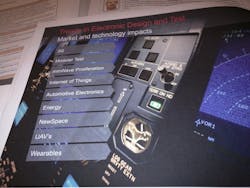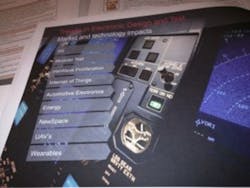Phoenix, AZ. Keysight Technologies is demonstrating its latest RF, microwave, and mmWave design and measurement solutions for R&D, manufacturing, and service at the IEEE MTT-S International Microwave Symposium in Phoenix this week. Keysight CTO Jay Alexander kicked off the proceedings this morning with an overview of the company’s IMS 2015 activities.
Keysight’s hardware, software, and technical expertise help users gain insight into the toughest component and system engineering challenges within the aerospace/defense, 4G/5G communications industries and for internet of things (IoT) applications.
Keysight is showcasing applications such as the following ones at its IMS 2015 booth:
- simulation of multi-emitter scenarios;
- new software to test IoT applications based on WLAN, Bluetooth, ZigBee, and Wi-SUN formats;
- a new flexible testbed for 5G waveform generation and analysis; and
- the latest lineup of modular instrument and software solutions addressing LTE-A MIMO and envelope tracking/digital predistortion (DPD) for power amplifiers.
Specific offerings on display at the show include the recently introduced new capability that adds a high-performance spectrum analyzer to its PNA and PNA-X Series microwave vector network analyzers (VNAs). This industry-first capability reduces test times by a factor of 10 to 500 times. Incorporating this functionality into a VNA simplifies system connections and saves time by putting high-speed spurious measurements in the instrument used to characterize S-parameters, compression, and distortion in satellite equipment, defense electronics, and commercial wireless devices.
The company is also demonstrating the Advanced Design System (ADS) Electro-Thermal Simulator, which provides accurate, temperature-aware IC simulation results by using device temperatures that take into account thermal coupling and thermal characteristics of the RFIC/MMIC component packaging.
Keysight experts are demonstrating critical capabilities of the Electro-Thermal Simulator, including
- accuracy, realized in the solution’s temperature-aware circuit simulation results based on state-of-the-art thermal solver technology;
- efficiency, brought about through the solution’s direct integration with the ADS layout environment and circuit simulators, which eliminates the need to transfer data to stand-alone thermal solvers; and
- speed, stemming from the solution’s high capacity thermal solver technology, which has been tested on SoC designs with thousands of components.
The ADS Electro-Thermal Simulator supports steady-state (harmonic balance, DC, AC, S-parameter) analysis and transient and envelope analyses. Engineers can use the simulator with GaAs, Si and SiGe, as well as a number of other process technologies. The simulator runs on the Linux 64-bit OS platform and also will soon support the Microsoft Windows OS platform.
Keysight also highlighted the M9451A PXIe Measurement Accelerator, a high performance FPGA processing card, which speeds envelope tracking (ET) and digital pre-distortion (DPD) characterization for power amplifier test. With the M9451A, engineers can make closed/open loop DPD and envelope tracking measurements in tens of milliseconds for up to a 100 times speed improvement.
The M9451A is now integrated with the RF PA/FEM Characterization and Test Reference Solution to provide even higher throughput while maintaining highly accurate S-parameter, harmonic distortion, power, and demodulation measurements. The Reference Solution enables full characterization of next-generation power amplifier modules, such as a power amplifier-duplexer (PAD).
The robust DPD algorithms in the Reference Solution came from years of close cooperation with wireless manufacturing customers and insights gained from Keysight’s SystemVue simulation and N7614B Signal Studio for Power Amplifier Test software applications. This makes it the only solution capable of providing consistent measurements, from simulation to manufacturing, for next-generation power amplifier modules.
In addition, Keysight highlighted the recently released version of its system-level electronic design automation software, SystemVue 2015.01. The release delivers the industry’s first commercial 5G simulation reference library, as well as direct integration of MATLAB Script from the MathWorks. SystemVue 2015.01 now enables 5G technology research, and increases productivity for system architects and baseband physical layer (PHY) designers working on additional wide bandwidth applications such as satellite communications and electronic warfare.
Keysight’s W1907BP 5G Forward Baseband Verification Library Bundle enables 4G designers to start anticipating 5G challenges today and continue forward into the final standard using a single configuration. The bundle combines existing 4G references for LTE-Advanced and the 3D WINNER+ MIMO channel model with forward-looking references for 5G PHY candidates, beginning with a full transmit/receive reference for Filter Bank Multi-Carrier (FBMC). It also adds legacy support for 2G/3G standards.
During his remarks this morning, Alexander alluded to NewSpace, which the company describes as a “…market disruption that hasn’t been seen since the original space race in the 1960s.” Keysight offers a white paper on the topic that “…describes the challenges that this new and unique business models put on electronic design and test strategies and processes. Shown are strategies to enable much higher volume test, with much lower cost yet maintaining high quality.”
NewSpace refers to Google, Facebook, Elon Musk, et al. wanting to bring internet to the whole world via satellite. The subject embraces everything from UAVs (drones) to wearables like Apple Watches and Fitbits.
Written by Rick Nelson with reporting from Publisher Jim Russell in Phoenix.
About the Author

Rick Nelson
Contributing Editor
Rick is currently Contributing Technical Editor. He was Executive Editor for EE in 2011-2018. Previously he served on several publications, including EDN and Vision Systems Design, and has received awards for signed editorials from the American Society of Business Publication Editors. He began as a design engineer at General Electric and Litton Industries and earned a BSEE degree from Penn State.


